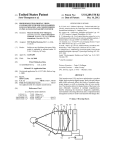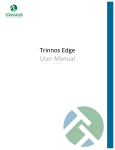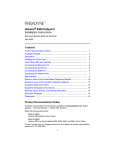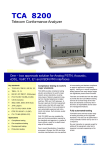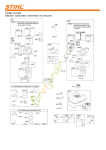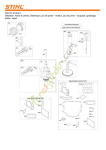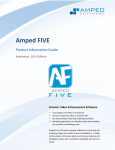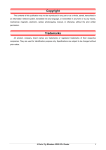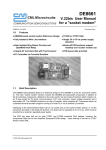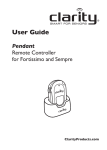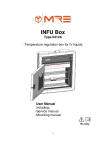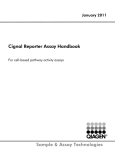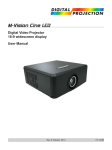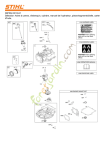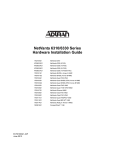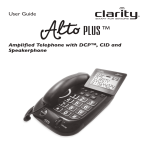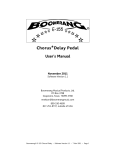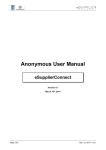Download FCC Part 68 FAQs - Telecommunications Industry Association
Transcript
Table of Contents NOTICE OF DISCLAIMER AND LIMITATION OF LIABILITY ......................................................................2 TR41.9 INTERPRETATIONS AND FREQUENTLY ASKED QUESTIONS ......................................................3 1.1. 1.2. 1.3. 1.4. 1.5. 1.6. 1.7. 1.8. 1.9. 1.10. 1.11. 1.12. 1.13. 1.14. 1.15. 1.16. 1.17. 1.18. 1.19. 1.20. 1.21. 1.22. 1.23. 1.24. 1.25. 1.26. 1.27. 1.28. 1.29. 1.30. 1.31. 1.32. 1.33. 1.34. 1.35. 1.36. 1.37. 1.38. 1.39. HAC TESTING ON PRODUCTS WITH A TONE CONTROL ..................................................................................3 MODEM – OFF-HOOK STATE ...........................................................................................................................3 ALLOWABLE NON-OPERATIONAL STATES AFTER TYPE A SURGES ................................................................ 4 CORDLESS PHONE - ON-HOOK IMPEDANCE ISSUES ........................................................................................5 LINE TESTER - 5 MEG DC RESISTANCE ISSUES............................................................................................... 5 ROLR ISSUES - TESTING ON SAME DIGITAL STATIONS USED IN DIFFERENT PBX SYSTEMS ..........................6 FACSIMILE HEADER MESSAGE REQUIREMENT ............................................................................................... 7 ROLR ISSUES - TESTING DIGITAL STATIONS .................................................................................................8 ROLR ISSUES - DIGITAL STATIONS TESTED THROUGH PBX INTERFACES .....................................................8 ROLR ISSUES - WIRELESS DIGITAL STATIONS AND PBX ANALOG TRUNKS ..............................................9 ROLR ISSUE - CRITERIA FOR "PRODUCT FAMILY" .....................................................................................9 ROLR ISSUES - POWER FAILURE MODE ................................................................................................... 10 ROLR ISSUES - WIRED DIGITAL STATIONS AND PBX ANALOG TRUNKS ................................................. 10 SURGE PROTECTORS TO GROUND - RATING ISSUES .................................................................................. 11 OPS TERMINAL EQUIPMENT..................................................................................................................... 12 ALARM DIALERS & LINE SEIZURE ISSUES ................................................................................................ 12 INTENTIONAL PATHS TO GROUND ............................................................................................................ 13 ALARM DIALERS ...................................................................................................................................... 14 FAILURE CONDITIONS AFTER SURGE STRESSES ....................................................................................... 14 SURGE TYPE B - ISSUES AND RECOMMENDATIONS................................................................................... 15 HOOK FLASH AND OFF HOOK ISSUES ....................................................................................................... 16 DIALING WITHOUT NETWORK ADDRESS PURPOSES ................................................................................. 16 RESERVED ................................................................................................................................................ 17 M-LEAD SURGE PROTECTION ISSUES ....................................................................................................... 17 PROPER SETTING OF SYNTHESIZED VOICE................................................................................................ 18 STAND-ALONE SURGES PROTECTORS WITH C.O. CONNECTIONS ............................................................. 18 COMPONENT APPROVAL ........................................................................................................................... 19 LEAKAGE AND COMPONENTS RATING ...................................................................................................... 19 VOLUME CONTROL QUESTION ................................................................................................................. 20 CONNECTIONS WITH PROTECTION PATHS TO GROUND ............................................................................. 21 ACCEPTABLE TYPE A SURGE FAILURE MODES ........................................................................................ 22 VOIP HAC REQUIREMENTS ..................................................................................................................... 22 MAXIMUM NUMBER OF DTMF DIGITS THAT MAY BE GENERATED BY A SINGLE KEY STROKE. ............. 24 DISCUSSION OF SECTION 1.3 IN TIA-968-B REGARDING CONTROL OF TE AFTER INSTALLATION ........... 25 CLARIFICATION OF A COMPONENT DEFINITION IN SECTION 6.1.2 OF TIA-968-B ..................................... 26 LAST DAY NEW PRODUCTS CAN BE APPROVED USING TIA-968-A? ....................................................... 26 RECEIVE VOLUME CONTROL - AUTOMATIC RESET ON HANG-UP ............................................................ 27 EQUIPMENT SUBJECT TO TIA-968-B REGISTRATION................................................................................ 28 ADSL MODEM DC RESISTANCE REQUIREMENT ...................................................................................... 29 1 Notice of Disclaimer and Limitation of Liability The information provided in this document is provided “as is” and “as available.” Such information is directed solely to professionals who have the appropriate degree of experience to understand and interpret its contents, and any and all use of or reliance upon this information is at the user’s own discretion and at its own risk. All warranties, express or implied, are disclaimed, including without limitation, any and all warranties concerning the accuracy of the information, its fitness or appropriateness for a particular purpose or use, its merchantability and its non-infringement of any third party’s intellectual property rights. TIA (together with its members, affiliates and sponsors, expressly disclaims any and all responsibilities for the accuracy of the information and makes no representations or warranties regarding the information’s compliance with any applicable statute, rule or regulation. TIA, and its members, affiliates and sponsors, expressly disclaim, and shall not be liable, for, any and all damages, direct or indirect, arising from or relating to any use of the information contained herein, including without limitation any and all indirect, special, incidental or consequential damages (including damages for loss of business, loss of profits, litigation, or the like), whether based upon breach of contract, breach of warranty, tort (including negligence), product liability or otherwise, even if advised of the possibility of such damages, except for such damages as may result directly from TIA’s intentionally unlawful or grossly negligent acts. The foregoing negation of damages is a fundamental element of the use of the information and data contained herein, and this information would not be published by TIA without such limitations. Questions or comments regarding this FAQ list may be sent to [email protected] or directly to TR-41 Chair Steve Whitesell ([email protected]). The FCC has a website with additional frequently asked questions located at http://transition.fcc.gov/wcb/iatd/part68faqs.pdf. 2 TR41.9 Interpretations and Frequently Asked Questions 1.1. HAC Testing On Products with a Tone Control BACKGROUND: 1. Part 68.316 states that a telephone handset is hearing aid compatible per 68.316 if it complies with RS-504 published by TIA in 1983 (and a copy of this TIA standard is included within 68.316 itself). 2. Clause 4.1.2 of RS-504 specifies that this performance must be measured per the "IEEE Standard Method For Measuring The Magnetic Field Intensity Around A Telephone Receiver (Ref: A6)". Appendix A of RS-504 contains reference A6 and says that this standard is "to be published". This standard was actually published in 1996 as IEEE Std 1027. 3. RS-504 and IEEE Std 1027 were both written and published before the FCC added the HAC Volume Control requirement to Part 68 (68.317). Both of these standards assume that the telephone does not have a receive volume control or a receive tone control (e.g. a 500 set). 4. TIA TSB-31-D (August 2011) "Part 68 Rationale and Measurement Guidelines" clause 14 provides the procedure for measuring compliance with the FCC's HAC Magnetic (68.316) requirements. Clause 14.1.8 (2) states: "For telephone sets which provide the ability to adjust the receive amplitude, the EUT can be deemed to be hearing aid compatible if the requirements of this section are met at any one of the available volume settings." ISSUES/PROBLEMS/QUESTIONS: For telephone sets which provide the ability to adjust the receive frequency response, can the EUT be deemed to be hearing aid compatible if the requirements of section 68.316 are met at any one of the available frequency response settings? REFERENCE(S): 47 CFR Section 68.316 RECOMMENDATION: CONTRIBUTION(S) WITH DETAILS: Email and subcommittee discussion. DATE OF RECOMMENDATION: (References updated February 2012.) 1.2. Modem – Off-hook state BACKGROUND: When a modem in a computer is connected to an Internet Service Provider and the user reboots the computer, the modem remains in the off-hook state. ISSUES/PROBLEMS/QUESTIONS: Does this product comply with the applicable requirements? REFERENCE(S): TIA-968-B, clause 5.1.11.3 3 RECOMMENDATION: Members of TR41.9 concurred that this is similar to the “off-hook forever state” in cordless phones, where the products would stay off-hook if RF link was lost. It was a consensus that, although we would not recommend this kind of a design, this situation did not violate the requirements. CONTRIBUTION(S) WITH DETAILS: TR41.9-01-08-055 DATE OF RECOMMENDATION: November 07, 2001 (Reference updated February 2012) 1.3. Allowable Non-Operational States After Type A Surges BACKGROUND: A manufacturer requested TR41.9’s clarification on the permissible states of the EUT after the Type A surges of clause 4.1.2 of TIA-968-B. The manufacturer wants to incorporate the surge protector as described in the attached specification sheet. This spec sheet states, among other things: "After a Type A surge the equipment can be faulty, provided that the fault mode causes the equipment to be unusable. The high current Type A surges (10/160, 200 A and 10/560, 100 A), will cause the TISP4xxxL3BJ to fail short circuit, giving a non-operational equipment pass to Type A surges." (See attached sheet on the TR41.9 web site contribution TR41.9-01-02-017). However the device as described would cause the supplier's EUT to place a short circuit (permanent off-hook) across tip and ring. ISSUES/PROBLEMS/QUESTIONS: 1. Are non-operational states after Type A surges allowed to include a short-circuit across Tip and Ring? 2. How widespread is the misunderstanding of the fail-safe criteria after Type A surges? How can suppliers be made more aware of the requirements? 3. What is a clear definition of acceptable “non-operational states” for the EUT after Type A surges? REFERENCE(S): TIA-968-B, clauses 4.1, 5.1.11.3 and 5.1.12.3 RECOMMENDATION: The equipment manufacturer is responsible for compliance of the complete, final assembled equipment. The component as described is not compliant with TIA-968-B, since it allows the final assembled equipment to provide a short across the line, which is an off-hook condition. This violates the requirements of TIA-968-B clauses 5.1.11.3 and 5.1.12.3. Equipment may not go off-hook permanently due to a fault mode. Section 4.1 of TIA-968-B allows a failure mode, but the failure mode is applicable only if the fault is readily visible to the user so that the equipment can be disconnected immediately. 2. Suppliers must not misunderstand the term “non-operational”, which does NOT mean “permanent off-hook or short” of the tip and ring interface. Suppliers may consult this site, attend TIA TR41.9 quarterly meetings, obtain TR41.9's contributions, or join TR41.9's mail reflector list. 2. Acceptable non-operational states of the EUT after Type A surges are: permanent on-hook (idle), permanent opening of the tip and ring line. On the other hand, the EUT must be able to continue to go on-hook and off-hook after Type B surges. The equipment in any case is never allowed to be permanently off-hook. CONTRIBUTION(S) WITH DETAILS: TR41.9-01-02-017 DATE OF RECOMMENDATION: February-21-2001 (References updated February 2012.) 4 1.4. Cordless Phone - On-Hook Impedance Issues BACKGROUND: A Telco investigated a cordless phone with the feature: "Press any key to cancel Find." Pressing the Talk key during a Find signal did cancel Find, but it also caused the phone to go off-hook. The Telco claimed this violated TIA-968B clause 5.5.11.3. It was said that, stripped to its essence for this issue, clause 5.111.3 reads: "Terminal equipment shall not by design leave the on-hook state . . . for any other purpose than to request service or answer an incoming call . . . ." It was claimed this phone was designed to go off-hook when canceling a Find signal, even absent any indication that a user might want to request service or answer a call. If the phone both cancelled Find and went offhook during (and only during) incoming ringing, that would have been acceptable, the Telco said. The Telco explained one possible network harm due to this as follows: When C.O. dial tone resources are already fully allocated, as during an area emergency or during the busy hour, one additional off-hook event can delay the presentation of dial tone to the next customer. This would degrade service to the next customer. This could be serious if the customer needed to make an emergency call. It was also stated that the user might not know they had taken the phone off-hook, so their line might be busied out unknowingly at an important time. Although not a network harm issue, this could inconvenience the household, making it difficult to place or receive emergency calls. The Telco did not propose to recall any phones, because the predicted incidence of network harm problems was infrequent and numerically small. However, it was requested that the Part 68 FAQ be updated to inform interested parties and improve compliance going forward. ISSUES/PROBLEMS/QUESTIONS: The claimed rule violation was that the Talk key both canceled Find (or Page), and simultaneously took the phone off-hook, when a Find signal was active and it could not be certain the user intended to request service or answer a call. Thus by design the phone went off-hook for a purpose other than requesting service or answering a call. REFERENCE(S): TIA-968-B, clause 5.1.11.3 RECOMMENDATION: It was recommended that cordless phone suppliers, in future products, prevent the Talk key (or equivalent) from causing a phone to go off-hook while canceling a Find or Page signal, unless there is simultaneous incoming ringing or another credible indication the user may intend to go off-hook. CONTRIBUTION(S) WITH DETAILS: TR41.9-00-08-038 DATE OF RECOMMENDATION: August-15-2000 (References updated February 2012.) 1.5. Line Tester - 5 Meg DC Resistance Issues BACKGROUND: A manufacturer has a circuit that is to be connected in series with approved terminal equipment. The circuit has a momentary manual switch that, when depressed, will allow the testing of the different conditions on the phone line. When the switch is not depressed, the unit passed all applicable requirements of TIA-968-B, including surge type B, etc. When the switch is depressed and held operated for testing purposes (it is a momentary switch, therefore, the switch is normally open), the resistance presented to the line is less than 5 Meg ohms. Thus, criteria in TIA-968-B clause 5.1.11.2.1 are not met. The switch is intended to be depressed when the unit is installed or when the line is being tested; however, a person would have to press the switch to do this. 5 ISSUES/PROBLEMS/QUESTIONS: Can this device be submitted for approval as a line tester, with instructions in the user's manual to warn the user of the non-compliance state? What are the harms presented to the network? What are the options to approve this equipment? REFERENCE(S): TIA-968-B, clause 5.1.11.2.1 RECOMMENDATION: The product is similar to a sophisticated punch-down block (but with modular connectors) that allows for connection of the telephone lines to separately approved equipment (such as telephone sets) via inside wiring. It was made clear that this equipment’s primary function was not a line tester but a distribution module. As part of the product’s secondary functions, a mechanical, momentary, switch marked “test” is provided and when the switch is depressed, it allows the testing of different conditions on the phone lines. However, when the switch is depressed, the equipment presented a low resistance (much less than the required 5 Meg Ohms) that does not comply with TIA968-B, clause 5.1.11.2.1. The main concern was that when the switch is depressed and the resistance presented to the line is less than 5 Meg Ohms, the CO equipment will detect this low current which corresponds to neither a true off-hook nor true on-hook state and this will prevent the carriers from conducting normal, usual line tests. CO line tests might be performed at any time of the day, not just in the middle of the night. At one time the equipment could be approved as having a Type Z ringer, which required the consent of the carrier for connection to its network. Another former option was to submit a waiver request to the FCC. Those options are no longer available. Our recommendation is that the manufacturer redesign the equipment to comply with TIA-968B in all operating states. CONTRIBUTION(S) WITH DETAILS: TR41.9-00-02-006 DATE OF RECOMMENDATION: February-22-2000 (References and recommendation updated February 2012.) 1.6. ROLR Issues - Testing on Same Digital Stations used in Different PBX Systems BACKGROUND: A manufacturer has a PBX that provides analog interfaces (i.e. loop start) as well as digital interfaces (i.e. T1 1.544 Mbps). The PBX provides wired proprietary digital station sets and wireless digital handsets. The station sets must meet the Volume Control (VC) ROLR requirements starting on January 2000. ISSUES/PROBLEMS/QUESTIONS: If several PBXs manufactured by the same company are using the same digital proprietary station sets, would it be sufficient to only test the digital proprietary station sets with one representative system and apply the test results across the entire product line? REFERENCE(S): 68.317 RECOMMENDATION: No. The test data can only be representative if the PBX systems are of a product family, using the same interface trunks and the same loss plan and the same digital proprietary telephone station interfaces. 6 CONTRIBUTION(S) WITH DETAILS: TR41.9-00-02-004 DATE OF RECOMMENDATION: November-9-1999 1.7. Facsimile Header Message Requirement BACKGROUND: In 1995 (CC Docket 92-90), the FCC issued rules requiring that FAX machines identify the sender of all messages, implementing provisions in the Telephone Consumer Protection Act of 1991. The intent was to control telemarketing cold calls and commercial nuisances such as automatic message dialers and junk FAX mail. These rules first appeared as section 68.318(c)(3), later moved to section 68.318(d): “Telephone facsimile machines; Identification of the sender of the message. It shall be unlawful for any person within the United States to use a computer or other electronic device to send any message via a telephone facsimile machine unless such message clearly contains, in a margin at the top or bottom of each transmitted page or on the first page of the transmission, the date and time it is sent and an identification of the business, other entity, or individual sending the message and the telephone number of the sending machine or of such business, other entity, or individual. Telephone facsimile machines manufactured on and after December 20, 1992, must clearly mark such identifying information on each transmitted message.” Manufacturers of FAX machines seeking Part 68 certification are also required to include a statement in their customer instructions that describes this requirement and tells the user how to set up the FAX header (this is sometimes also called “FAX branding”). A sample of this statement is required in Exhibit J of the application for certification (see chapter in the “Part 68 Application Guide” on “Customer Information”). In April 1997, responding to requests from MCI, Sprint, and Ameritech (see FCC document 97-117 or TR41.9-97-05-051), the FCC clarified situations where the originator and the transmitter of a FAX may be different entities or individuals, specifically with regard to broadcast services. The FCC defined “sender” as the creator of the FAX message content, not the service who sends it. Consequently, each FAX must identify the business, entity, or individual who created the FAX rather than the entity who transmits the message. In cases where the message originator and sender agree to both be identified on the FAX, it must be clear which is responsible for the message content and which is merely the message transmitter. ISSUES/PROBLEMS/QUESTIONS: A recent query from a FAX machine manufacturer asked: “… then it seems that the responsibility for conformity is on the user, so long as we take the appropriate measures to assure that they can comply and know what they are doing. Do you agree with this?” REFERENCE(S): 68.318(d), “Telephone facsimile machines; Identification of the sender of the message” RECOMMENDATION: The questioner is correct, but to clarify so there is no misunderstanding, FAX machine manufacturers are required to: 1) Provide a means to insert the FAX header in every FAX transmission. 2) Follow the instructions for customer information in the “Part 68 Application Guide,” specifically: a) Advise the customer about the requirement and the need to always use the FAX header when sending a FAX (specific language in the Guide). b) Provide clear and simple instructions to the customer telling how to enter the required information in the FAX header. c) Include a copy of these customer instructions in Appendix J of the application for certification. 3) Manufacturers are further advised to put the header set-up instructions in an easily accessible location and to make this process easy, making it easy for their customers to comply with this requirement. CONTRIBUTION(S) WITH DETAILS: TR41.9-99-11-087 7 DATE OF RECOMMENDATION: November-9-1999 1.8. ROLR Issues - Testing Digital Stations BACKGROUND: A manufacturer has a PBX that provides analog interfaces (i.e. loop start) as well as digital interfaces (i.e. T1 1.544 Mbps). The PBX provides wired proprietary digital station sets and wireless digital handsets. The station sets must meet the Volume Control (VC) ROLR requirements starting on January 2000. ISSUES/PROBLEMS/QUESTIONS: Are the station sets required to be tested for the VC ROLR requirements by themselves? REFERENCE(S): 68.317 RECOMMENDATION: If the station sets are digital and proprietary and cannot be used by themselves without the system, they must be tested with the system CONTRIBUTION(S) WITH DETAILS: TR41.9-00-02-004 DATE OF RECOMMENDATION: November-9-1999 1.9. ROLR Issues - Digital Stations Tested Through PBX Interfaces BACKGROUND: A manufacturer has a PBX that provides analog interfaces (i.e. loop start) as well as digital interfaces (i.e. T1 1.544 Mbps). The PBX provides wired proprietary digital station sets and wireless digital handsets. The station sets must meet the Volume Control (VC) ROLR requirements starting on January 2000. ISSUES/PROBLEMS/QUESTIONS: Through what interface of the PBX must the digital station sets be tested for VC ROLR? Analog (i.e. loop start) or Digital (i.e. T1) or both? 2. Should the PBX and the station set be considered as one big Black Box Telephone for the purposes of VC ROLR testing? REFERENCE(S): 68.317 RECOMMENDATION: Both. The PBX loss plan plays an important role in the test for the reason that when the station set was tested through an analog interface of the PBX, the network perceives the complete entity as one black box analog giant phone; when the station set was tested through a digital interface of the PBX, the network perceives the complete entity as one black box digital giant phone. Thus, different loss compensations will be applied by the system. Therefore in order to verify the appropriate loss compensation, the digital station should be tested through both the analog and digital interfaces of the PBX, unless the PBX does not provide both types of interfaces 2. Yes, as indicated above. 8 CONTRIBUTION(S) WITH DETAILS: TR41.9-00-02-004 DATE OF RECOMMENDATION: November-9-1999 1.10. ROLR Issues - Wireless Digital Stations and PBX Analog Trunks BACKGROUND: A manufacturer has a PBX that provides analog interfaces (i.e. loop start) as well as digital interfaces (i.e. T1 1.544 Mbps). The PBX provides wired proprietary digital station sets and wireless digital handsets. The station sets must meet the Volume Control (VC) ROLR requirements starting on January 2000. ISSUES/PROBLEMS/QUESTIONS: If the PBX only provides an analog interface, must the wireless station meet the ROLR in all 3 loop lengths, as specified? Should the air link matter? REFERENCE(S): 68.317 RECOMMENDATION: Through the analog interface of the PBX, the wireless digital station set should still be tested for all 3 specified loop lengths. This also applies to cordless phones (cordless handset working in conjunction with a base station connected to the network via a regular wireline loop start line) which must compensate for the losses over the different loop lengths. CONTRIBUTION(S) WITH DETAILS: TR41.9-00-02-004 DATE OF RECOMMENDATION: November-9-1999 1.11. ROLR Issue - Criteria for "Product Family" BACKGROUND: A manufacturer has a PBX that provides analog interfaces (i.e. loop start) as well as digital interfaces (i.e. T1 1.544 Mbps). The PBX provides wired proprietary digital station sets and wireless digital handsets. The station sets must meet the Volume Control (VC) ROLR requirements starting on January 2000. ISSUES/PROBLEMS/QUESTIONS: How should product lines be differentiated for the purpose of ROLR testing? By family designation? By FCC Registration designation? REFERENCE(S): 68.317 RECOMMENDATION: Examples of a product family include systems that differ only in capacity (i.e., 4x8, 6x12 systems, where the "bigger brother" differ only in the fact that it can accommodate more capacity). Station sets must be tested for each PBX that is different (not part of the family) as the PBX loss plan, and its interface trunks as well as station interfaces do have 9 an effect on the same digital proprietary station sets. A Product family should be differentiated by the above criteria rather than by FCC Registration Number, as sometimes, a "big brother" system that has received the same FCC Registration Number may incorporate additional interface trunks, etc. than the "little brother" system covered under the same FCC Number. The key issue in compliance is whether the test data obtained for compliance is representative enough. When in doubt, ensure that each station set complies. CONTRIBUTION(S) WITH DETAILS: TR41.9-00-02-004 DATE OF RECOMMENDATION: November-9-1999 1.12. ROLR Issues - Power Failure Mode BACKGROUND: Many multifunction corded telephones that use AC-powered power adaptors now on the market will continue to function as a standard telephone after loss of AC power to the adaptor, but will lose many of their functions such as LCD display, speaker-phone, and Volume Control. ISSUES/PROBLEMS/QUESTIONS: Is it required to provide the Volume Control feature in the event of a power failure? (Note: Industry Canada CS-03 exempts compliance with the Volume Control in the case of AC power failure) REFERENCE(S): 68.317 RECOMMENDATION: The receive gain requirements apply to telephone sets that are fully operational. They do not apply during AC power failure, if a telephone set is designed to operate with AC-adapter powering. CONTRIBUTION(S) WITH DETAILS: TR41.9-99-11-084 DATE OF RECOMMENDATION: November-9-1999 1.13. ROLR Issues - Wired Digital Stations and PBX Analog Trunks BACKGROUND: A manufacturer has a PBX that provides analog interfaces (i.e. loop start) as well as digital interfaces (i.e. T1 1.544 Mbps). The PBX provides wired proprietary digital station sets and wireless digital handsets. The station sets must meet the Volume Control (VC) ROLR requirements starting on January 2000. ISSUES/PROBLEMS/QUESTIONS: If the PBX only provides an analog interface, must the wired digital station meet the ROLR in all 3 loop lengths, as specified? REFERENCE(S): 68.317 10 RECOMMENDATION: Through the analog interface of the PBX, the wired digital proprietary station set must be tested for all 3 loop lengths, the reason being that when the station set is tested through an analog interface of the PBX, the network perceives the complete entity as one black box analog giant phone; when the station set is tested through a digital interface of the PBX, the network perceives the complete entity as one black box digital giant phone. Thus, different loss compensations will be applied by the system. CONTRIBUTION(S) WITH DETAILS: TR41.9-00-02-004 DATE OF RECOMMENDATION: November-9-1999 1.14. Surge Protectors to Ground - Rating Issues BACKGROUND: The product is a channel bank FXO board containing multiple identical interfaces that are software-selectable to be either loop start or ground start interfaces. In the ground start mode, a ring-to-ground solid state relay circuit is activated by software. In the loop start mode, the circuit is functionally disabled but the circuit hardware is still present. The solid state relay in the circuit has a breakdown rating of less than 1000 V. This caused the interface (in the loop start mode) to fail the leakage current limitations requirements of TIA-968-B, clause 4.2 [in the ground start mode, the interface is exempt from the tests of TIA-968-B, clause 4.2 and does meet the ground current capabilities requirements of TIA-968-B, clause 4.3.4.1. ISSUES/PROBLEMS/QUESTIONS: The interface incorporates surge protectors to ground which normally would have operated to clamp hazardous voltages to ground before the ring-to-ground solid state relay breaks down, however, Part 68 requires the protectors to be disconnected for the leakage tests, which leaves the solid state circuit unprotected and thereby allowed to reach its breakdown voltage. This situation is seen to be unlikely to happen in real life since the protectors would have operated before the solid state circuit breaks down. The suggestion of a hardware strap was not seen as desirable to the manufacturer as the board incorporates several identical interfaces and the board would have to be removed from the host chassis backplane for straps to be changed, causing the operation of several lines to be disrupted. REFERENCE(S): TIA-968-B, clauses 4.2 and 4.3.4.1 RECOMMENDATION: If the interface can prove it has dielectric barriers through other components in the circuit (transformers, relays), in the loop start mode, with the ground connection removed from the ring-to-ground resistor (and with the surge protectors removed from the circuit), then it would be considered compliant with the spirit of Part 68. It was suggested to the manufacturer to submit his Part 68 application to the FCC with test data showing compliance as specified, in both the loop start mode and the ground start mode. CONTRIBUTION(S) WITH DETAILS: TR41.9-99-11-063 DATE OF RECOMMENDATION: August-18-1999 (References updated February 2012.) 11 1.15. OPS Terminal Equipment BACKGROUND: TIA-968-B clause 5.1.16 gives requirements for OPS terminal equipment. It states that there are different requirements for different classes of OPS equipment. What are the differences in the classes and where can one find the definitions for each class of OPS? ISSUES/PROBLEMS/QUESTIONS: Three classes of OPS are referenced in TIA-968-B as A, B, and C. REFERENCE(S): TIA-968-B, clause 5.1.16 RECOMMENDATION: Off-premise station (OPS) ports of premises communication systems (e.g., private branch exchanges or key telephone systems) provide dc loop supervision network control signaling and talking battery to the remote OPS stations. The difference between each OPS class is the loop lengths that can be supported between the various OPS ports and the remote stations. Testing performed on an OPS port must show compliance with all of the requirements in clause 5.1.16. OPS ports shall provide at least 16 mA of loop current across the range of resistances for the applicable type of OPS port (class A, class B, or class C) as shown in the table in clause 5.1.16.1. In addition, class B or class C interfaces shall provide at least 20 mA of DC loop current into the OPS line simulator circuit under the conditions shown in the table in clause 5.1.16.2. CONTRIBUTION(S) WITH DETAILS: TR41.9-98-11-077 DATE OF RECOMMENDATION: August-17-1999 (References and recommendation updated February 2012.) 1.16. Alarm Dialers & Line Seizure Issues BACKGROUND: A manufacturer markets an alarm control panel with associated control devices. In the event of an emergency situation, the alarm control panel would seize the line, pulse the line at a rate of 100 pps for 1 second to signal the other control devices that are connected to the telephones on the inside wiring of the house. Upon detecting this pulse signal, each associated control device would disconnect the telephone instrument to which it is connected, thus freeing the telephone line for the alarm control panel to dial out. ISSUES/PROBLEMS/QUESTIONS: The issue is on compliance with TIA-968-B, clause 5.1.11.3 that allows loop-start terminal equipment to go off hook only for the purpose of answering an incoming call or originating a call. This alarm control panel would be going off hook for purposes other than those allowed. The problems revolve around the line seizure conditions and characteristics of an alarm control panel. In the past, this type of devices would be wired in the house ahead of all other telephone sets (cc USOC RJ31X) so that in the event of an emergency, the device would disconnect all the other telephones and dial out. In the present environment, often the alarm device is added to the house after several telephones have been wired and connected and there is no easy way to ensure that the alarm control panel will be wired ahead of all other devices. REFERENCE(S): TIA-968-B, clause 5.1.11.3 12 RECOMMENDATION: If at least one telephone is already off-hook, there is no issue with compliance with TIA-968-B, clause 5.1.11.3 [line already off hook] B. If all associated telephones are on-hook, and the alarm control panel goes off-hook, performs its pulsing sequence and continues to stay off-hook in order to subsequently network address (dial out), then it will comply with TIA-968-B, clause 5.1.11.3. This is the suggested design to the manufacturer of the alarm panel. C. If all associated telephones are on-hook, and the device goes off-hook, performs its pulsing sequence and then goes on hook to wait for the associated instruments to free the line, it would technically violate the requirements of TIA-968B, clause 5.1.11.3. It was mentioned that, however, this device intends to subsequently use the line to dial out, and the efforts to clear the line would be seen by network operators as less "harmful" than if the device were to use the line to open a door phone controller, for example. It was mentioned that the series of pulses from the device may be seen as a 100 Hz signal and the signal is then subject to the signal power requirements of TIA-968-B, clause 5.1. If the signal power of the resulting signal complies with the loop start requirement of -9dBm, then the device could be considered as Part 68 compliant (given the emergent circumstances) even though it technically violates the requirements of TIA-968-B, clause 5.1.11.3. This solution is not seen as desirable as the one suggested in subparagraph B above. CONTRIBUTION(S) WITH DETAILS: TR41.9-99-08-060 DATE OF RECOMMENDATION: August-17-1999 (References updated February 2012.) 1.17. Intentional Paths to Ground BACKGROUND: TIA-968-B, clause 4.2.5 allows for intentional operational paths to ground (as in DID and ground start interfaces) to be excluded from the 1000 V leakage test. Leads excluded for this purpose must be subjected to the tests of TIA968-B, clause 4.3.4.1 for ground integrity demonstration. A manufacturer has an E1/T1 CSU interface card. In the T1 mode, there is no intentional operational path to ground. However, in the E1 mode, there is a circuit to ground that would cause the device to fail the leakage test. This circuit may or may not affect the transverse balance characteristics of the T1/CSU. ISSUES/PROBLEMS/QUESTIONS: Is the circuit for E1 operation considered an intentional operational path to ground? Should the card have a jumper that would disconnect the circuit to ground in T1 operation? REFERENCE(S): TIA-968-B, clause 4.2 Leakage Current Limitations and TIA-968-B, clause 4.3.4.1 Connection with operational paths to ground. RECOMMENDATION: Since the intentional path to ground is not an inherent function for T1 operation, and the E1 interface is not covered in TIA-968-B, the exemption for intentional path is not allowed. The terminal equipment must comply with the requirements of TIA-968-B for TTE with a DS1 interface. Alternatively, the equipment could be designed to effectively disconnect the path to ground in T1 operation, such as the use of a jumper. CONTRIBUTION(S) WITH DETAILS: Issue was discussed during a meeting. No contribution. DATE OF RECOMMENDATION: February-18-1999 (References and recommendation updated February 2012.) 13 1.18. Alarm Dialers BACKGROUND: A manufacturer has a PBX system with a dial out modem. The modem will only dial out if some of the hardware in the system has crashed. The modem will dial out to a paging service to contact a technician. The tech will then take the necessary repair to the PBX system. The auto-redial attempts from the modem can be set well beyond the specification of Part 68 Subpart D section 68.318(b). Would this equipment qualify for registration as an alarm dialer? ISSUES/PROBLEMS/QUESTIONS: According to the note to 68.318(b)(1), emergency alarm dialers and dialers under external computer control are exempt from the limitations placed on automatic redialing functions in 68.318(b). REFERENCE(S): 68.318(b) RECOMMENDATION: Yes. Note the statement in the November 1997 Order that Emergency alarm dialers and dialers under external computer control are exempt from these requirements. Note the definition in the Application Guide for equipment code AL implies that Alarm dialing systems fire, intrusion, equipment failure and the like. An internal modem within a terminal equipment, when used in emergency conditions such as the one described qualifies for the exemption under Emergency dialers, even though the terminal equipment primary function is not of an alarm dialer. CONTRIBUTION(S) WITH DETAILS: TR41.9-98-11-077 DATE OF RECOMMENDATION: November-18-1998 (Issue clarified and references updated February 2012.) 1.19. Failure Conditions After Surge Stresses BACKGROUND: What constitutes failure for the Type A surge test? ISSUES/PROBLEMS/QUESTIONS: Surge stresses are environmental conditioning tests. REFERENCE(S): TIA-968-B, clause 4.1.2.3 RECOMMENDATION: Since surge stresses are conditioning tests, the Terminal Equipment must undergo all the applicable electrical tests after the surges. Any failure to comply with the criteria of all applicable Sections of TIA-968-B after the surges constitutes a failure. This determination applies to both Type A and Type B surges. Note: Pursuant to TIA-968-B, clause 4.1.2.3, the Terminal Equipment is allowed to reach some failure modes in violation of the transverse balance requirements of TIA-968-B Section 5 provided that such failure modes are intentionally designed and that the equipment would become substantially and noticeably unusable by the user, or an indication would be given (e.g. alarm) in order for the equipment to be immediately disconnected from the telephone line. CONTRIBUTION(S) WITH DETAILS: TR41.9-98-11-077 14 DATE OF RECOMMENDATION: November-18-1998 (References updated February 2012.) 1.20. Surge Type B - Issues and Recommendations BACKGROUND: Failure modes resulting from application of Type B telephone line surges are specified in TIA-968-B, clause 4.1.3.3: "Approved terminal equipment and approved protective circuitry shall withstand the energy of Type B surge without causing permanent opening or shorting of the interface circuit and without sustaining damage that will affect compliance with this Standard. ISSUES/PROBLEMS/QUESTIONS: Need for better definition of "permanent opening", perhaps relating to a minimum amount of current drawn from the interface. 2. Need for more precise specification of what can happen after the Surges Type B: equipment does not need to transmit, etc. 3. Need for better specification of the tests necessary to be performed after the Surges Type B (i.e., all tests, a subset of tests, etc.) REFERENCE(S): TIA-968-B, clause 4.1.3.3 RECOMMENDATION: It is necessary to perform ALL tests for those states achievable after application of the Type B surge. This is necessary to ensure that equipment continues to be in compliance with the requirements of TIA-968-B. Often, the very last test to be performed is the one yielding a failure to meet the appropriate criteria. A transverse balance failure for example may not be apparent visually until the equipment is tested according to Section 5. The following premise was used as the basis for the recommendation: An operational test alone may not cover the effects of the Type B surge stress on the terminal equipment. If ALL the required tests were NOT performed after the Type B surges, equipment that had not undergone this complete testing after the Type B surges may harbor non-compliance parameters that would surface later in subsequent modification filings and would be extremely difficult to trace, especially if different test labs were used. Non-uniformity of test data could create widespread complaints to the FCC and foster difficulties of tracing the problems for the manufacturers and test labs. TR41.9 recommends obtaining complete applicable test data (1) before stresses, (2) after Type B stresses, and (3) after Type A stresses. Regarding the state of the equipment after the Surge Type B, TR41.9 committee agreed that the equipment under test must go on-hook and off-hook (or provide an idle and active state, for interfaces not drawing loop current), but other functionalities (data transmission, DTMF dialing, etc.) are not necessary. Some examples of equipment conditions after Type B stress and their acceptability: OK Equipment continues to go onhook and off-hook Equipment needed to be reset Cycling of power, whether through commercial power or batteries NOT OK Equipment remains permanently on-hook Equipment remains permanently off-hook Replacing components in interface, e.g., fuses, transformers, relays, etc. Replacing components such as ROM chip in control circuit, or fuse in power supply circuit CONTRIBUTION(S) WITH DETAILS: TR41.9-98-02-033, TR41.9-98-02-038, and TR41.9-98-02-040 DATE OF RECOMMENDATION: February-16-1998 (References, background information, and recommendation updated February 2012.) 15 1.21. Hook Flash and Off Hook Issues BACKGROUND: A manufacturer designs a door phone system comprised of a door bell and a relay system that would connect a door speakerphone directly to the house phone. While on the phone with a remote caller, if the owner hears his house doorbell, he would hookflash, then be connected to the visitor at the door speakerphone; the outside line is on hold and would be re-connected after a second hook flash. If the house phone is not being used at the time a visitor rings the bell, the owner can pick up the house phone, hook flash, then be connected to the visitor at the door speakerphone. ISSUES/PROBLEMS/QUESTIONS: Would this device violate the requirements of TIA-968-B, clause 5.1.11.3 which states: “Transitioning to the off-hook state: Except as provided in 5.1.11.3.1 and 5.1.11.3.2 below, approved terminal equipment and approved protective circuitry shall not by design leave the on-hook state by operations performed on tip and ring leads for any other purpose than to request service or answer an incoming call. Make-busy indications shall be transmitted by the use of make-busy leads only as defined in clause 3.1.” REFERENCE(S): TIA-968-B, clause 5.1.11.3 RECOMMENDATION: When the user was already off hook in an ongoing conversation, there is no harm generated whereas when the user picked up the phone to answer the doorbell while not requesting network services would be considered as violating TIA-968-B, clause 5.1.11.3. It was mentioned that CPE is allowed to go off hook for programming purposes (See 5.1.11.3.1) and stutter dial tone detection (See 5.1.11.3.2), and that the hook flashing situation could be construed as another application of “exceptional uses”. The hookflash area was considered to be a “gray” area, and timing considerations were discussed. In the end, it was concurred that, although the user of a CPE may be the one initiating the action, and that CPE, not users, fall under the jurisdiction of Part 68, CPE should not be designed in such a way that would allow the user to intentionally violate TIA-968-B requirements. Note: The intent of Section TIA-968-B, clause 5.1.11.3 is to prevent PERMANENT shorting of the telephone line. Going off hook and drawing dial tone without a request for network services is a violation of TIA-968-B, clause 5.1.11.3 in the truest sense. However, since the hook flashing lasts basically for a very short period, there should be no network harm generated in the practical sense. CONTRIBUTION(S) WITH DETAILS: TR41.9-98-02-011 DATE OF RECOMMENDATION: February-16-1998 (References updated and issues clarified February 2012.) 1.22. Dialing Without Network Address Purposes BACKGROUND: A manufacturer designs a door phone system comprised of a door bell and a relay system that would connect a door speakerphone directly to the house phone. While on the phone with a remote caller, if the owner hears his house doorbell, he would hook flash, dial a 2-digit number, and then be connected to the visitor at the door speakerphone; the outside line is on hold and would be re-connected after a second hook flash. If the house phone is not being used at the time a visitor rings the bell, the owner can pick up the house phone, hook flash, dial a 2-digit number, and then be connected to the visitor at the door speakerphone. 16 ISSUES/PROBLEMS/QUESTIONS: Would this device violate the requirements of TIA-968-B, clause 5.1.11.3? Section 5.1.11.3 states: “Transitioning to the off-hook state: Except as provided in 5.1.11.3.1 and 5.1.11.3.2 below, approved terminal equipment and approved protective circuitry shall not by design leave the on-hook state by operations performed on tip and ring leads for any other purpose than to request service or answer an incoming call. Make-busy indications shall be transmitted by the use of make-busy leads only as defined in clause 3.1. REFERENCE(S): TIA-968-B, clause 5.1.11.3.1 RECOMMENDATION: It was unanimously concluded that the case where the door controller was activated by the use of digit dialing, definitively violates TIA-968-B, clause 5.1.11.3.1. In the end, it was concurred that, although the user of a CPE may be the one initiating the action, and that CPE, not users, fall under the jurisdiction of Part 68, CPE should not be designed in such a way that would allow the user to intentionally violate TIA-968-B requirements. CONTRIBUTION(S) WITH DETAILS: TR41.9-98-02-011 DATE OF RECOMMENDATION: February-16-1998 (References updated and issues clarified February 2012.) 1.23. Reserved 1.24. M-Lead Surge Protection Issues BACKGROUND: TIA-968-B, clause 4.2 allows for protection paths to ground to be separately evaluated under clause 4.3.4.2, however, under this section, the protection component must undergo a test voltage of 120V or 300V to ground. MLead surge protection to ground on the A side of the interface is normally a zener rated at 60-80VDC. This device would fail the 4.3.4.2 requirements. ISSUES/PROBLEMS/QUESTIONS: Specifically exclude M-lead protection paths to ground, in E&M circuits on the A side of the interface? REFERENCE(S): TIA-968-B, clauses 4.2 and 4.3.4.2 RECOMMENDATION: EUT which have intentional conducting paths to ground and are therefore deferred from High Voltage AC leakage tests contained in CS-03's 2.2.1/TIA-968-B, clause 4.2 shall, if that path is an operational intentional path, require only the ground integrity test of 2.3.9.1/TIA-968-B, clause 4.3.4.1. Even if there should also be a protective intentional path to ground in the same network interface, the operational path takes exclusive precedence over the protective, negating the requirement for the I-Leakage test. Only those EUT with protective-only paths to ground shall require the I-Leakage test of 2.3.9.2/TIA-968-B, clause, 4.3.4.2. CONTRIBUTION(S) WITH DETAILS: TR41.9-97-05-033 17 DATE OF RECOMMENDATION: May-1-1997 (References updated February 2012.) 1.25. Proper Setting of Synthesized Voice BACKGROUND: Multi-media devices have the capabilities of an answering machine, i.e. they allow recording from an internal/external source and playback of machine-generated messages. In some cases, the MIC input is located on the host computer that is not part of the approved equipment. Host computer software may also allow volume adjustments for recording and/or playback. ISSUES/PROBLEMS/QUESTIONS: Does the card manufacturer have to set the maximum level? REFERENCE(S): TIA-968-B, clause 5.1 RECOMMENDATION: The card must limit the maximum output to the network to less than the allowed maximum level of its class of service (i.e. less than -9 dBm for loop start, less than -11 dBm for a tie trunk, etc.), in the worst case scenario (with the input levels to the card at maximum, etc.). CONTRIBUTION(S) WITH DETAILS: TR41.9-95-06-020 DATE OF RECOMMENDATION: June-1-1995 (References and recommendation updated February 2012.) 1.26. Stand-Alone Surges Protectors with C.O. Connections BACKGROUND: Surge protectors are getting more and more sophisticated. Some are actually power line outlet bars with telephone jacks where front-end secondary protection circuitry is provided for tip and ring inputs. This may include series fusible resistors and parallel varistors. ISSUES/PROBLEMS/QUESTIONS: 1. The varistors may draw enough current to provide a high load on the line during ringing. 2. Potential open circuit of the fusible resistors after the surges (not allowed under Type B of TIA-968-B, clause 4.1.3). 3. Are these devices required to be approved under Part 68? REFERENCE(S): TIA-968-B, clauses 5.1.11.2 and 4.1.3 RECOMMENDATION: If these devices are not electrically transparent (i.e., with resistors in series and surge suppressors in parallel with tip and ring of the associated approved equipment), they must be Part 68 approved, due to their potential effect on compliance of the associated approved equipment with the requirements of TIA-968-B, 4.1.3 (Type B surges), 4.2 (Leakage), 5.1 (in-band and out-of-band noise), 5.1.10 (Longitudinal Balance) and 5.1.11.2 (on hook impedance). 18 CONTRIBUTION(S) WITH DETAILS: TR41.9-95-06-021 DATE OF RECOMMENDATION: June-1-1995 (References updated February 2012.) 1.27. Component Approval BACKGROUND: Modem and other PC modules have been approved as OEM devices to be installed in a final assembly. There are differences between OEM devices: modem cards vs. modules plugging into a host mother board that provides tip and ring and ground traces to backplane of host systems, etc. ISSUES/PROBLEMS/QUESTIONS: Non-compliance may occur causing longitudinal balance and leakage problems if tip and ring traces are too close to ground through various paths on the host system. Host devices may have other components (such as filter caps) to ground that may cause on-hook impedance problems, etc. Non-compliant network connectors may be provided by the host assembly. REFERENCE(S): TIA-968-B, section 6 RECOMMENDATION: See section 6 of TIA-968-B for component device guidance. CONTRIBUTION(S) WITH DETAILS: TR41.9-95-06-023 DATE OF RECOMMENDATION: June-1-1995 (References updated and subject clarified February 2012.) 1.28. Leakage and Components Rating BACKGROUND: A circuit designer wanted to use the same telephone interface coupling transformer, used in a similar device that is Part 68 approved. When he found out from the transformer manufacturer that the component is rated lower than the TIA-968-B required 1000 V, he contacted TR41.9 to see if he could still use the component. At the same time, he had the component tested at a private lab and the sample tested happened to pass the leakage test of TIA-968-B, clause 4.2. He wanted TR41.9 to allow him to use the component. Component rating of the interface has been required to ensure that dielectric components used in the interface are designed to withstand the proper voltage - not just in the sample tested. ISSUES/PROBLEMS/QUESTIONS: How should components be rated and how do these ratings relate to TIA-968-B, Section 4.2 requirements? Should the leakage current limit be reduced? REFERENCE(S): TIA-968-B, clause 4.2 Leakage current limitations 19 RECOMMENDATION: If a component in the telephone interface circuit is relied upon for dielectric isolation barrier, then it is recommended that this component be rated at 1000 Vrms. There is no recommendation for changing the present maximum allowed leakage current of 10 mA peak. CONTRIBUTION(S) WITH DETAILS: TR41.9-95-06-022 DATE OF RECOMMENDATION: June-1-1995 (References updated February 2012.) 1.29. Volume Control Question BACKGROUND: ISSUES/PROBLEMS/QUESTIONS: Can an FCC Part 68 compliant device employ a volume control allowing a gain greater than 18 dB without automatically resetting? REFERENCE(S): 68.317 RECOMMENDATION: The FCC has instituted an expedited waiver process that allows phones to have an override switch to defeat the automatic reset provided all of the following safety considerations for advising the user are also implemented: (1) The volume reset override switch shall be labeled as such and located on the telephone in such a way as to not be accessible to accidental engagement; (2) a bright indicator light shall be prominently displayed on the front of the telephone and shall light up when the override is engaged and the telephone is placed in an off-hook condition; (3) next to the light shall be a warning that the amplification is at a high level; (4) a caution on the use of the volume reset override switch shall be included in the users' manual; and (5) the telephone includes a warning printed in Braille that can be securely attached to the back of the handset, or, if the telephone has only a headset, above the dial buttons, to indicate that a high volume setting may be engaged. To request such a waiver, submit a written request to the FCC testifying to the above. For more information see FCC document DA 01-578, “Memorandum and Order in the Matter of Tandy Corporation, Walker Equipment Company, Ameriphone, Inc., and Ultratec, Inc., Request for Wavier of Volume Control Reset, 47CFR Section 68.317(f).” Paragraph 15 provides detail on requesting a waiver and paragraph 17 provides an official statement of the above requirements. CONTRIBUTION(S) WITH DETAILS: TR41.9-06-11-005M DATE OF RECOMMENDATION: November 2006 (References updated February 2012.) 20 1.30. Connections with Protection Paths to Ground BACKGROUND: This is a question regarding the leakage current test of clause 4.2 of TIA-968-B. If a customer’s equipment is placed inside a metal, grounded box, then they will be required to meet the current leakage test where 1,000 volts is connected between tip/ring and the exposed metal surface of the box. The overvoltage protection device (a SIDACtor device, MOV, GDT, or whatever), is removed for this test. If the resultant current flow exceeds 10 mA, it is deemed a failure. If the circuit contains transistors, capacitors, or other devices that are connected between tip or ring, and that same ground, and these components are rated for a few hundred volts, those components will break down and conduct, failing the test thus requiring very robust and costly, 1,000+ volt rated components; OR the circuit ground reference must be isolated from the case ground. And any circuit with a protection path to ground is subjected to clause 4.3.4.2. ISSUES/PROBLEMS/QUESTIONS: Are 1000 volt rated components always required for compliance to TIA-968-B in this case? And for circuits with intentional path to ground (clause 4.3.4.2), why is the voltage level restricted to 120V for approved terminal equipment and 300Vrms for protective circuitry? REFERENCE(S): TIA-968-B, clause 4.2 Leakage current limitations and clause 4.3 Hazardous Voltage limitations RECOMMENDATION: Clause 4.3.4.2would read better if it had been written as “….120Vrms for approved terminal equipment and 300Vrms for approved protective circuit.” Thus the reader would quickly refer to the definition section for a definition of the term “approved protective circuitry.” Approved protective circuitry: Separate, identifiable and discrete electrical circuitry designed to protect the telephone network from harm, which is approved in accordance with the rules and regulations. Examples are surge suppressors, signal power suppressors, etc. designed as a separate piece of equipment to be placed in front of terminal equipment. A historical perspective: "... the three-phase voltage used in commercial buildings vs. residences (hence the 300VAC vs. the 120VAC). This reason came from one of the early AT&T publications (in the 1970's) regarding protective couplers. This was AT&T-provided equipment used to connect the customer's own equipment to the network, and in the early days AT&T leased the coupler to the customer. The couplers were subjected to AT&T standard for couplers. After deregulation, couplers could also be manufactured and marketed by parties other than AT&T, so the standard for the 300 V hazardous voltages for couplers was retained in Part 68. Furthermore, connections with operational paths to ground are tested differently from the guidelines in section 4.3. Quoting from clause 4.3.4.1: “Approved terminal equipment and approved protective circuitry having an intentional dc conducting path to earth ground at operational voltages that was excluded during the leakage current test of section 4.2 shall have a dc current source applied …..The voltage ……shall not exceed 0.1 V at any time. In the event there is a component or circuit in the path to ground, the requirement shall be met between the grounded side of the component or circuit and the earth grounding connection.” This dc current test may therefore allow the use of more cost effective components. CONTRIBUTION(S) WITH DETAILS: TR41.9 DATE OF RECOMMENDATION: February 5, 2008 (References updated February 2012.) 21 1.31. Acceptable Type A Surge Failure Modes BACKGROUND: ISSUES/PROBLEMS/QUESTIONS: When we test T1 (DS1) equipment after influence of Type A surge the device fails. The device under test does not transfer pulses (pulse shape - failed); however it passes the transverse balance tests. Some ports fail transverse balance and have remained connected to the ground through 100-300 Ohm. According to clause 4.1 of TIA-968-B the TE "shall comply with all the criteria specified in this standard, both prior to and after application of the mechanical and electrical stresses". According to clause 4.1.2.3 of TIA-968-B, for Type A surges equipment and circuitry are allowed to be in violation of the transverse balance requirements of section 5. There is a difference of opinion as to whether the device fails or passes in view of the transverse balance requirements being met. Please clarify. REFERENCE(S): TIA-968-B, clause 4.1.2.3 RECOMMENDATION: Clause 4.1 of TIA-968-B specifies that all technical criteria must be met by TE before and after surging. However, an exception is allowed for transverse balance. If the equipment fails Transverse Balance as a result of Type A surging – and that failure is due to some intentional grounding of a tip or ring protection component in the network interface which connects either tip or ring or both to ground as a result of the surge, and if that condition of the equipment will be immediately recognizable to the user who will therefore be quickly disconnecting it from the PSTN, this Transverse Balance failure mode is considered acceptable under TIA-968-B clause 4.1.2.3(b). If, however, Transverse Balance fails as a result of Type A surging and it is not due to some intentional fail-safe grounding characteristics expected of network protection components used, but is due to something such as destruction of network interface circuitry and consequent imbalance, then the equipment fails the Type A surge test. Regarding the device no longer transmitting pulses, if the failure to transmit pulses is caused by a distorted pulse shape that falls outside the mask, then the device fails the Type A surge. However, if the device just quits sending pulses (effectively sending all zeros), and that condition will be immediately recognizable to the user (e.g., via an alarm) who can then quickly disconnect it from the PSTN, then the device does not fail the Type A surge. CONTRIBUTION(S) WITH DETAILS: TR41.9-07-02-011 DATE OF RECOMMENDATION: (Issues clarified and references and recommendation updated February 2012.) 1.32. VoIP HAC Requirements BACKGROUND: ISSUES/PROBLEMS/QUESTIONS: Are VoIP telephones required to meet volume control and hearing aid compatibility (HAC) requirements? 22 REFERENCE(S): RECOMMENDATION: Yes. FCC Report & Order FCC 07-110, adopted May 31, 2007 and released June 15, 2007 addressed IP Enabled Services (WC Docket No. 04-36) and Implementation of Section 255 of the Communications Act (WT Docket No. 98-198). Paragraph 16 of the R&O includes the following statement: “We require providers of ‘interconnected VoIP service,’ as defined by the Commission and manufacturers of equipment or CPE that is specially designed to provide this service, to comply with disability access requirements mirroring those in section 255 and in the Commission’s section 255 rules.” Similarly, paragraph 20 includes the following statement: “We also apply disability access obligations mirroring those under section 255 to any equipment or CPE specially designed to provide interconnected VoIP service and that is needed to effectively use an interconnected VoIP service.” Paragraph 28 states: “If ‘readily achievable,’ a covered manufacturer of equipment or CPE that is specially designed to provide interconnected VoIP service must ensure that the equipment is designed, developed, and fabricated so that any portion of the equipment that is used for interconnected VoIP service is accessible to and usable by individuals with disabilities, if readily achievable. Whenever this requirement is not readily achievable, the manufacturer must ensure that the equipment is compatible with existing peripheral devices or specialized CPE commonly used by individuals with disabilities to achieve access, if readily achievable. A covered manufacturer also must ensure that information and documentation provided in connection with covered interconnected VoIP equipment or CPE is accessible, if readily achievable.” Appendix B to the R&O then gives the specific wording changes to 47 C.F.R. 6 so that it includes interconnected VoIP service and the equipment (network and customer premises) required to provide interconnected VoIP service. 47 C.F.R. 6.3 (a) defines the term accessible to include: 1) availability of auditory information for people who are hard of hearing and 2) hearing aid coupling 47 C.F.R. 6.3(a)(2)(v) states that the “availability of auditory information for people who are hard of hearing” means to “Provide audio or acoustic information, including any auditory feedback tones that are important for the use of the product, through at least one mode in enhanced auditory fashion (i.e., increased amplification, increased signal-tonoise ratio, or combination).” 47 C.F.R. 6.3(a)(2)(ix) states that “hearing aid coupling” means “Where a product delivers output by an audio transducer which is normally held up to the ear, provide a means for effective wireless coupling to hearing aids.” Thus, the FCC 07-110 R&O appears to require phones intended for use with interconnected VoIP service to provide "enhanced auditory information for people who are hard of hearing" and “hearing aid coupling" if readily achievable. The requirements that demonstrate compliance with receive volume control and hearing aid coupling are in 47 C.F.R. Part 68.316 & 317. Clause 14 of TIA TSB-31-D (Rationale and Measurement Guidelines for U.S. Network Protection) has test procedures for determining compliance with Part 68.316 (hearing aid coupling) & 317(receive volume control) that may be extended to VoIP phones. CONTRIBUTION(S) WITH DETAILS: TR41.9-08-08-007 23 DATE OF RECOMMENDATION: May 6, 2008 (References updated February 2012.) 1.33. Maximum Number of DTMF Digits That May be Generated by a Single Key Stroke. BACKGROUND: TIA-968-B clause 5.1.4 places the following limits on internal signal sources primarily intended for network control signaling: The maximum power in the frequency band below 3995 Hz delivered to a loop simulator circuit shall not exceed the following when averaged over any 3-second interval: a) 0 dBm when used for network control (for example, DTMF, MF, and coin control signals); b) 0 dBm when DTMF is used for manual entry end-to-end signaling and the device does not generate more than 40 DTMF digits per manual key stroke; c) -9 dBm in all other cases (for example, when a device generates more than 40 DTMF digits per manual key stroke in end-to-end signaling applications). Thus, Telephone Terminal Equipment (TTE) may not generate DTMF signals for network control signaling or any other application at a signal power level greater than 0 dBm when averaged over any 3 second interval. There is no limit on the number of DTMF digits that TTE may generate in response to a single key stroke in network control signaling applications. The maximum number of DTMF digits that a device may generate in response to a single key stroke in end-to-end signaling applications is 40 when the measured signal power level is ≤ 0 dBm and > –9 dBm when averaged over any 3 second interval. There is no limit on the number of DTMF digits that TTE may generate in response to a single key stroke in end-toend signaling applications when the measured signal power level is – 9 dBm or less when averaged over any 3 second interval. ISSUES/PROBLEMS/QUESTIONS: A manufacturer has TTE with a DTMF signal generator that is capable of being used to generate DTMF network control signals as well as DTMF signals for end-to-end signaling applications. The TTE cannot distinguish the call state, therefore it has no way of differentiating between network control signaling and end-to-end signaling applications. The TTE uses the same signal power level for both applications and the device generates the same maximum number of DTMF digits with a single key stroke for either application. Thus, although there is no limit on the number of DTMF network control signals that can be generated with a single key stroke, the fact that most TTE cannot determine the call state means that the 40 digit limit for end-to-end signaling applications is, for all practical purposes, a defacto limit on the maximum number of network control signals that can be generated by a single key stroke. How can the 40 DTMF digit limit be avoided? REFERENCE(S): TIA-968-B clause 5.1.4 RECOMMENDATION: In cases where TTE uses the same DTMF output signal power levels in all applications, including network control signaling and end-to-end signaling, the TTE designer can avoid a limit on the maximum number of DTMF digits that may be automatically generated by a single key stroke by keeping the measured DTMF signal power level at –9 dBm or less. This can be accomplished by striking a balance between the DTMF output signal level, the DTMF signal duty cycle, and the timing between DTMF digits. For example, if the maximum DTMF output level is -6 24 dBm, a 50% duty cycle will produce a measured level of -9 dBm averaged over 3 seconds. Likewise, if the maximum DTMF output level is -3 dBm, a 25% duty cycle will produce a measured level of -9 dBm averaged over 3 seconds. CONTRIBUTION(S) WITH DETAILS: TR41.9-08-11-014L DATE OF RECOMMENDATION: November-2-2008 (References updated February 2012.) 1.34. Discussion of Section 1.3 in TIA-968-B Regarding Control of TE After Installation BACKGROUND: Section 1.3 states “The adjustment of any real or virtual control that is readily accessible by, or intended to be accessible to the user, either locally or remotely, shall not cause the TE to become noncompliant with this Standard.” ISSUES/PROBLEMS/QUESTIONS: Would it apply to a modem that can be configured for use in other countries? For example, setting the modem for operation in a country other than the US may cause it to be noncompliant to this standard. Another example is a T1/E1 interface that can be user configured via software to be either a T1 or E1 interface. Obviously an E1 interface would not meet the requirements. Is the statement in Section 1.3 relevant to these situations? REFERENCE(S): TR41.9-09-11-007 RECOMMENDATION: If the control setting does not change the interface type, then the TE must continue to comply with all of the applicable requirements of TIA-968-B and 47 C.F.R. Part 68 for any interface covered by TIA-968-B. If the control setting changes the interface type to another interface covered by TIA-968-B, then the TE must comply with all of the applicable requirements of TIA-968-B and 47 C.F.R. Part 68 for that control setting. If the control setting changes the interface type to an interface not covered by TIA-968-B, then the TE must comply with section 4 of TIA-968-B and 47 C.F.R. Part 68 with that control setting and must be non-operational when connected to any interface covered by TIA-968-B. CONTRIBUTION(S) WITH DETAILS: DATE OF RECOMMENDATION: November 11, 2009 25 1.35. Clarification of a Component Definition in Section 6.1.2 of TIA-968-B BACKGROUND: Section 6.1.2 states “Host-independent components shall demonstrate compliance with the applicable technical criteria in this Standard and 47 C.F.R. Part 68 by testing with at least three types of approved host components or host terminal equipment identified by the Responsible Party in the test report and customer instructions.” ISSUES/PROBLEMS/QUESTIONS: In general the definition of a component would seem to encompass terminal equipment such as modems (DSL or traditional) which only operate when connected to a communications port (Serial, USB or Ethernet) on a computer. Is this a fair interpretation? For example, in testing a USB modem, one end connects to the PSTN, the other to a USB port on a computer. Does the above requirement mean that the device should now be tested with three separate computers or would the "types" be interpreted as simply tested when connected to a USB port regardless of the where that USB port originates? Of course if the USB modem is not considered a component (even though it depends on the host for power and operational control) this becomes a non-issue. REFERENCE(S): TR41.9-09-007 RECOMMENDATION: Yes, it is considered a component and should be tested with three separate computers. CONTRIBUTION(S) WITH DETAILS: DATE OF RECOMMENDATION: November 11, 2009 1.36. Last Day New Products Can be Approved Using TIA-968-A? BACKGROUND: ISSUES/PROBLEMS/QUESTIONS: What is the last day that a new product can be approved using TIA-968-A? REFERENCE(S): RECOMMENDATION: March 22, 2011 is the last day a NEW product can be approved using the TIA-968-A standard. After that date, NEW products are to be approved using TIA-968-B. CONTRIBUTION(S) WITH DETAILS: DATE OF RECOMMENDATION: January 17, 2010 (Subject and recommendation clarified February 2012) 26 1.37. Receive Volume Control - Automatic Reset on Hang-Up BACKGROUND: Section 47 C.F.R. 68.317(f) concerning volume control reset when the gain exceeds 18 dB states: “The 18 dB of receive gain may be exceeded provided that the amplified receive capability automatically resets to nominal gain when the telephone is caused to pass through a proper onhook transition in order to minimize the likelihood of damage to individuals with normal hearing.” The term “nominal gain” is not directly defined elsewhere in Part 68, but the term has been interpreted as the “normal unamplified level” used as the gain measurement reference (i.e., 0 dB) as discussed in 47 C.F.R. 68.317(e): “The ROLR for either an analog or digital telephone shall first be determined with the receive volume control at its normal unamplified level. The minimum volume control setting shall be used for this measurement unless the manufacturer identifies a different setting for the nominal volume level. …” However, a telephone may have two means of controlling the receive volume: one in which the receive gain can be adjusted up to a maximum value that does not exceed 18 dB, and a second that provides an extra gain boost exceeding 18 dB. The on-hook transition then automatically removes the extra gain boost and returns the volume control to the original receive gain level. This feature may be desirable when the phone is used on a long loop with substantial loss such that people with normal hearing may find some receive gain desirable and a person with diminished hearing using the same phone may need to activate the extra gain boost. Another scenario is where one person with a small hearing loss who regularly uses the phone with the conventional volume control and another person who occasionally uses the same phone has a greater hearing loss and needs to activate the extra gain boost feature. ISSUES/PROBLEMS/QUESTIONS: The clear intent of 68.317(f) is to “minimize the likelihood of damage to individuals with normal hearing” on subsequent uses of the telephone when 18 dB of receive gain is exceeded. Therefore, automatically resetting the receive gain to a value of 18 dB or less through a proper on-hook transition should suffice. If the receive gain is a value of 18 dB or less, an automatic reset is not required by 68.317. In the specific example cited of a telephone with two means of controlling the receive volume, removing the extra gain boost provided by the second volume control and reverting to a receive gain value of 18 dB or less provided by the first volume control as a result of a proper on-hook transition should be satisfactory. REFERENCE(S): 47 CFR 68.317(f); 47 CFR 68.317(e) RECOMMENDATION: The consensus of TR41.9 is that a telephone providing more than 18 dB of receive gain, which automatically resets to a receive gain value of 18 dB or less when a proper on-hook transition occurs, complies with 47 CFR 68.317(f). CONTRIBUTION(S) WITH DETAILS: TR41.9-10-02-017-L, TR41.9-10-02-018M DATE OF RECOMMENDATION: February-10-2010 27 1.38. Equipment Subject to TIA-968-B Registration BACKGROUND: Questions arise as to what equipment is subject to TIA-968-B and CS03 registration. ISSUES/PROBLEMS/QUESTIONS: Committee TR41.9 discussed this topic and developed a typical list of equipment that is subject to TIA-968-B registration. REFERENCE(S): Not applicable. RECOMMENDATION: What are some typical Customer Premises Equipment (CPE) that must comply with TIA-968-B (USA) or CS03 (Canada) for connection to wireline carrier networks in North America? • Plain Old (analog) Telephone Service (POTS) telephones, fax machines, modems, and other RJ11 connected equipment • PBXs, Gateways, and routers with any of the following interfaces: • • • • • • • • Direct Inward Dialing (DID) trunk E911 loop reverse-battery outgoing E&M (e.g., analog tie trunks) Off-premises station line (Class A, B, and C) FXO ports with loop-start or ground start capabilities DS1 (T1) and ISDN PRI (1.544 Mbps) ports ISDN BRI ports (U & S/T) Public Safety Answering Point Systems (PSAPs) with any of the following interfaces: • • • loop reverse-battery incoming DS1 (T1) and ISDN PRI (1.544 Mbps) ports E&M (e.g., analog tie trunks) • Private line equipment with ringdown, voice band metallic, or in-band signaling • Local area data channel • Subrate (e.g., 1.2, 2.4, 4.8, 9.6, and 56 kbps) Digital Data System (DDS) Equipment • Public Switched Digital Service (PSDS) Types I, II, and III • DS1 (T1) and ISDN PRI (1.544 Mbps) • ISDN BRI ports (U & S/T) • DSL splitters and micro-filters • DSL modems and equipment including: • • • • • • • IDSL ADSL, ADSL2, ADSL2+, and reach extended ADSL2 (READSL2) SHDSL and ESHDSL HDSL2, SMC4, and HDSL4 SDSL SMC6, VDSL, and VDSL2 SMC2, SMC3, SMC7, SMC8, and other DSL CONTRIBUTION(S) WITH DETAILS: 28 TR41.9-10-05-014M DATE OF RECOMMENDATION: May-05-2010 1.39. ADSL Modem DC Resistance Requirement BACKGROUND: This issue deals with measurement of on-hook resistance for an ADSL modem. ISSUES/PROBLEMS/QUESTIONS: When performing the on-hook dc resistance requirements test in clause 5.1.11.2.1 and 5.1.11.2.2 of ANSI/TIA-968B for an ADSL modem, fluctuating low level voltage (~1.2 V) and current (~3 uA) have been detected at the tip and ring port when the ADSL modem is powered up but no voltage is being applied by the test equipment. In addition, when dc voltages (from 1V to 200V) are applied, the currents are almost the same as the values with no DC voltage applied by the test equipment. Could you tell me whether the product fails to meet the requirements? REFERENCE(S): ANSI/TIA-968-B clauses 5.1.11.2.1 and 5.1.11.2.2. RECOMMENDATION: The product does not meet the requirement. Having a voltage at tip & ring would cause the interface to fail the DC Resistance test. An xDSL over POTS interface should not have any dc voltage at its tip & ring leads. Typically an xDSL over POTS interface will have a capacitor between the transformer windings towards the tip & ring leads or two blocking capacitors, one in series between the tip lead and the transformer and one in series between the ring lead and the transformer. This would block any DC coming in or going out the interface. The xDSL over POTS interface needs to be in the "quiet state" when preforming all of the on-hook impedance and Transverse Balance tests. If this interface does have capacitors to block DC, then the xDSL chip may not be in the "quiet state" and sending training tones in the band above 25 kHz. These tones can also cause the interface to fail the on-hook impedance tests. The low level signal on the tip and ring leads that is causing problems with the dc resistance measurements may actually be the high frequency training tones. CONTRIBUTION(S) WITH DETAILS: TR41.9-13-05-005-EmailExchangeReADSLModemResistance TR41.9-13-05-006-ADSLModemDCResistanceRequirement TR41.9-13-05-012-M-FAQ-Draft DATE OF RECOMMENDATION: May-01-2013 29





























